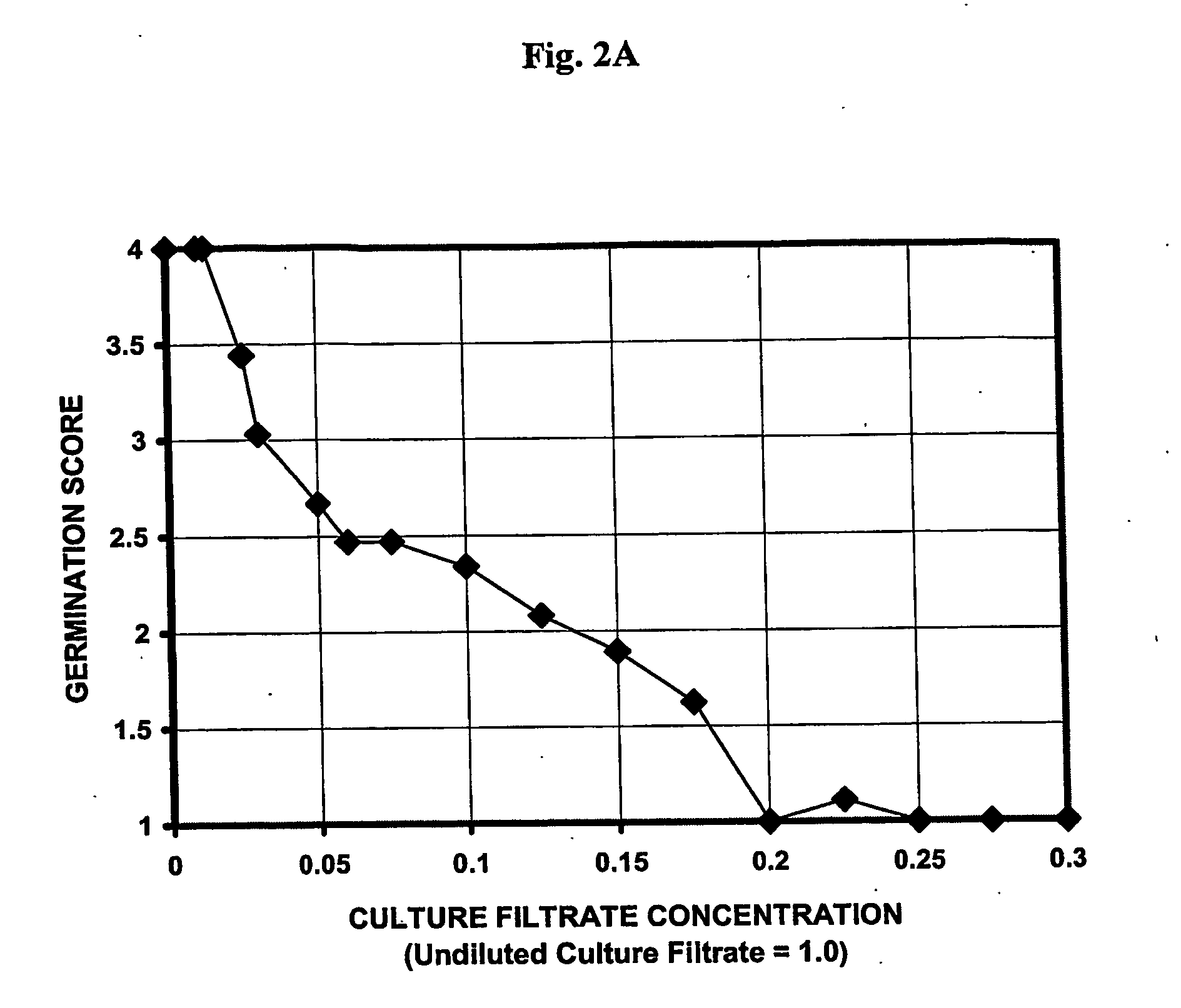Bacterial bioherbicide for control of grassy weeds
a bioherbicide and grassy weed technology, applied in the field of pseudomonas fluorescens and pseudomonas putida strains, can solve the problems of reduced number of registered chemical herbicides, similar difficulties for grass seed producers in central and eastern Europe, and inability to withstand the effects of bacterial bioherbicides, so as to inhibit or arrest the germination of grassy weeds
- Summary
- Abstract
- Description
- Claims
- Application Information
AI Technical Summary
Benefits of technology
Problems solved by technology
Method used
Image
Examples
example 1
General Methods
A. Growth of Bacterial Cultures
[0251]Pseudomonas isolates stored in cryovials (50% glycerol, −60° C.) were inoculated into Wheaton bottles half-filled with Pseudomonas Minimal Salts Medium (PMS). The tops of the bottles were loosely capped and secured with tape. The bottles were placed on a rotary shaker (200 rpm) in a 27° C. chamber and allowed to grow for 7 days prior to harvest
B. Pseudomonas Minimal Salts Medium (PMS)
[0252] The PMS medium used was developed by Gasson (Applied and Environmental Microbiology (1980). 39:25-29). The medium is made as follows: Dissolve 0.2 g potassium chloride, 1.0 g ammonium phosphate, 2.0 g sodium phosphate (monobasic), and 4.96 g sodium phosphate (dibasic) in distilled water to make 1 liter final volume. Autoclave. Allow the medium to cool and then add 2 ml of a sterile solution of 20% (w / v) magnesium sulfate (heptahydrate) and 20 ml of a sterile 10% (w / v) glucose solution per liter of autoclaved medium.
C. Preparation of Cult...
example 2
Selection of Pseudomonas Isolates that Arrest Germination of the Seeds of Grassy Weeds
Summary
[0261]Pseudomonas bacteria were isolated from the rhizosphere of Poa, Triticale, Triticum, Hordeum, and Lolium species. These bacterial isolates were screened initially for the ability of live cultures to cause stunting of the roots and shoots of young seedlings of the grassy weed known as annual bluegrass (Poa annua). Isolates selected in this manner were evaluated further by testing the ability of live cultures to arrest the germination of seeds of Poa annua. Twelve isolates were active in this test, and culture filtrates prepared from these isolates also were active in arresting the germination of the seeds of Poa annua. On the basis of the latter bioassay, these isolates were presumed to produce and secrete a Germination-Arrest Factor (GAF) into the culture medium. Five of the more active isolates (WH6, E34, AD31, AH4 and WH19) were selected for further study. These five isolates were...
example 3
Biological Activity of the Germination-Arrest Factor (GAF) from Pseudomonas fluorescens isolates WH6 and E34
Summary
[0267] Bacteria-free culture filtrates of Pseudomonas fluorescens isolates WH6 and E34 irreversibly arrest the germination of seeds of annual bluegrass (Poa annua) at a stage immediately following emergence of the coleorhiza and plumule. Successive dilutions of the culture filtrates elicit a decreasing array of developmental disturbances, which are scored and used to estimate the relative concentration of GAF responsible for these effects. The effects of GAF are both species-specific and developmentally specific. Seeds of wheat, barley, and corn were unaffected by GAF treatment, but seed germination was arrested in a large number of other graminacious species, including a number of grassy weeds. The seeds of the dicots tested were unaffected.
[0268] In sensitive seeds, the effects of GAF are specific for the early stages of seed germination; foliar applications of GA...
PUM
| Property | Measurement | Unit |
|---|---|---|
| molecular weight | aaaaa | aaaaa |
| pH | aaaaa | aaaaa |
| v/v | aaaaa | aaaaa |
Abstract
Description
Claims
Application Information
 Login to View More
Login to View More - R&D
- Intellectual Property
- Life Sciences
- Materials
- Tech Scout
- Unparalleled Data Quality
- Higher Quality Content
- 60% Fewer Hallucinations
Browse by: Latest US Patents, China's latest patents, Technical Efficacy Thesaurus, Application Domain, Technology Topic, Popular Technical Reports.
© 2025 PatSnap. All rights reserved.Legal|Privacy policy|Modern Slavery Act Transparency Statement|Sitemap|About US| Contact US: help@patsnap.com



